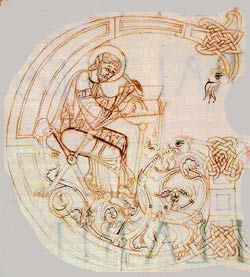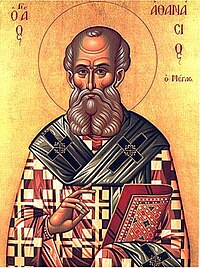
The “Hillary” in pink is NOT the one we’re talking about today…
Wednesday, January 13, is the Feast Day for St. Hilary. And the “Hillary” we’re talking about today is not the one shown in the image above.
But note first that the term “feast” here doesn’t mean a large meal. (As in a family celebration.) Instead it refers to a religious celebration dedicated to a particular saint.
 In this case, Saint Hilary was born in Poitiers, a city in France. (Some 210 miles southwest of Paris.) We don’t know exactly when he was born. (Either “at the end of the 3rd or beginning of the 4th century A.D.” Best guess: somewhere around 310 A.D.)
In this case, Saint Hilary was born in Poitiers, a city in France. (Some 210 miles southwest of Paris.) We don’t know exactly when he was born. (Either “at the end of the 3rd or beginning of the 4th century A.D.” Best guess: somewhere around 310 A.D.)
For the Bible readings of the day – and a short biography – see Hilary, from the “Satucket” Lectionary. (That page included the image at left, apparently related to Hilary. For more on the image, right-click “Search Google for image.”) And speaking of Hilary, we’re not real sure when he died either. But according to St. Jerome, he died in Poitiers in 367.
(Jerome was a noted priest, confessor, theologian, historian, and Doctor of the Church.)
Hilary’s parents were pagans – “of distinction.” And he was said to have had a “good pagan education, which included a high level of Greek.” His name came from the Latin for “happy” or “cheerful.” And somewhere between 350 and 353, the Christians of Poitiers “so respected Hilary” that they unanimously elected him their bishop.
 The problem was that Hilary served as bishop at the time of a great early-church conflict: The one pitting Athanasius – shown at right – against Arius. (For whom Arianism was named.)
The problem was that Hilary served as bishop at the time of a great early-church conflict: The one pitting Athanasius – shown at right – against Arius. (For whom Arianism was named.)
Arianism is the nontrinitarian belief that Jesus, as the Son of God, was “created by God the Father.” In other words, that “God the Father and the Son of God did not always exist together eternally.”
For more information on the conflict, see Arian controversy:
The Arian controversy … arose between Arius, a priest and theologian, and Bishop Athanasius, a Church Father. The most important of these controversies concerned the substantial relationship between God the Father and Jesus Christ. These disagreements divided the Church into two opposing theological factions for over 55 years … until after the Council of Constantinople in 381. There was no formal resolution or formal schism[.] The Catholic church eventually formed its own theology on this matter.
In a nutshell, the issue was whether Jesus was of the “same substance” as God – the Athanasian position – or of (merely) a “similar substance.” (The position held by Arius.)
The argument may sound pretty obtuse to us today. But back in the mid-300s, it was immensely important. It had just been some 40 years – since around 313 – that Christianity had been “decriminalized.” (It changed from being a persecuted religion to one that was “tolerated” by the Roman state. In documents including the Edict of Milan.)
 And contrary to the popular assertion that Roman emperor Constantine the Great made Christianity Rome’s official religion, that didn’t happen in 313.
And contrary to the popular assertion that Roman emperor Constantine the Great made Christianity Rome’s official religion, that didn’t happen in 313.
The image at right shows Constantine’s conversion. (As “imagined by Rubens.”) But despite that conversion, Constantine “continued to support both Christianity and paganism. In 314, the cross appeared on Constantine’s coins, but so did the figures of Sol Invictus and Mars.” (Mars was the Roman god of war. See also “to hedge your bets.”)
In fact, Christianity wasn’t made Rome’s official religion until 380 – or 391 – under Theodosius I.
The point is this: That at the time of the Arian controversy, the stakes were pretty high. (Basically the future of the Western Church was at stake.) Then too, Roman emperors changed their minds quite often. That’s what happened to St. Hilary. For a time the Emperor backed the Arian argument, which led to Hilary getting exiled for four years.
On that note, the Gospel for Hilary’s day – Luke 12:8-12 – included this:
“When you are brought before synagogues, rulers and authorities, do not worry about how you will defend yourselves or what you will say, for the Holy Spirit will teach you at that time what you should say.”
Those are the words of Jesus, in Luke 12:11 and 12:12. And they pretty much summed up what Hilary had to go through, facing up to the Roman emperor Constantius II.
Constantius II ultimately followed a compromise position – between Arius and Athanasius. (“Retrospectively called Semi-Arianism.”) But in 356 A.D., he found the Arian position persuasive enough to banish Hilary to Phrygia for four long years. (At the time, Phrygia – in the west central part of what is now Turkey – was something of a backwater of the Roman Empire.)
Put another way, for his strong defense of Athanasius, “Hilary has often been referred to as ‘Athanasius of the West.'” But in 356, he essentially backed the wrong horse.
 On the other hand, Hilary put his four years in exile to good use. He honed his arguments so well that they ultimately acquired the force of (church) law. In essence he was a “Great Dissenter” over 1,500 years before Supreme Court justice Oliver Wendell Holmes, Jr. (Holmes’ “dissents were often prescient and acquired so much authority that he became known as ‘The Great Dissenter.'” He is shown at right.)
On the other hand, Hilary put his four years in exile to good use. He honed his arguments so well that they ultimately acquired the force of (church) law. In essence he was a “Great Dissenter” over 1,500 years before Supreme Court justice Oliver Wendell Holmes, Jr. (Holmes’ “dissents were often prescient and acquired so much authority that he became known as ‘The Great Dissenter.'” He is shown at right.)
Which is another way of saying “Athanasianism” ultimately won the day.
In fact – and as a bit of an aside – you can see the full text of the Athanasian Creed in today’s Book of Common Prayer. (Under the link, Historical Documents of the Church, and/or beginning on page 864, under the “Council of Chalcedon” entry. For more on the Creed, see the notes.)
But note also that Athanasius wrote his creed “during his exile in Rome.” In fact, Athanasius got exiled five times during his bishopric, mostly because succeeding emperors kept changing their minds. (Between “orthodoxy” and Arianism.) Which could go to show that some of the great writing in history has come from people “in exile.” (See e.g. Prison literature – Wikipedia.)
Be that as it may, on January 13 we remember Hilary of Poitiers, the 4th-century philosopher:
[His] studies made him a champion of orthodox Trinitarian theology during one of the most difficult periods of Church history. He protected the Church and its members by brilliantly defending the sacred humanity of Jesus while also defeating aranism which denied Christ’s divinity. St. Hilary was a gentle and courteous man, devoted to writing some of the greatest theology on the Trinity, and … in being labeled a “disturber of the peace.” In a very troubled period in the Church, his holiness was lived out in both scholarship and controversy.
Which could show that sometimes God’s work means being “a disturber of the peace.”

“The ordination of Saint Hilary of Poitiers…”
* * * *
The upper image is courtesy of Hillary Clinton – Wikipedia, the free encyclopedia. The caption: “The Clinton family takes an Inauguration Day walk down Pennsylvania Avenue to start President Bill Clinton’s second term in office, January 20, 1997.”
The text of this post was gleaned from from sources including Hilary of Poitiers – Wikipedia, ST. HILARY OF POITIERS :: Catholic News Agency (CNA), CATHOLIC ENCYCLOPEDIA: St. Hilary of Poitiers, and What is Arianism? – GotQuestions.org.
Re: Constantine’s conversion, said to happen in 313. See Constantine … and Christianity – Wikipedia:
[When] Constantine the Great reigned … Christianity began to transition to the dominant religion of the Roman Empire. Historians remain uncertain about Constantine’s reasons for favoring Christianity, and theologians and historians have argued about which form of Early Christianity he subscribed to… Some scholars question whether he should be considered a Christian at all … and he did not receive baptism until shortly before his death.
[His] decision to cease the persecution of Christians in the Roman Empire was a turning point for Early Christianity… In 313, Constantine and Licinius issued the Edict of Milan decriminalizing Christian worship. The emperor became a great patron of the Church and set a precedent … and the notion of orthodoxy, Christendom, ecumenical councils and the state church of the Roman Empire declared by edict in 380.
As noted above, the edict in 380 – or 391 depending on the source – was promulgated by Theodisius.
Re: Athanasius and his Creed. Note that his first exile was to Gaul (to what is now Trier in Germany). His second exile was a type of “protective custody” in Rome, where he wrote his Creed. Later exiles included his twice “withdrawing” into the desert of Upper Egypt, and lastly an exile of a few months to the outskirts of Alexandria, where he had been serving as bishop. As to the Creed:
The Latin name of the creed, Quicunque vult, is taken from the opening words, “Whosoever wishes.” The creed has been used by Christian churches since the sixth century. It is the first creed in which the equality of the three persons of the Trinity is explicitly stated.
The lower image is courtesy of Hilary of Poitiers – Wikipedia. The full caption indicated that the image was gleaned from a 14th-century manuscript.